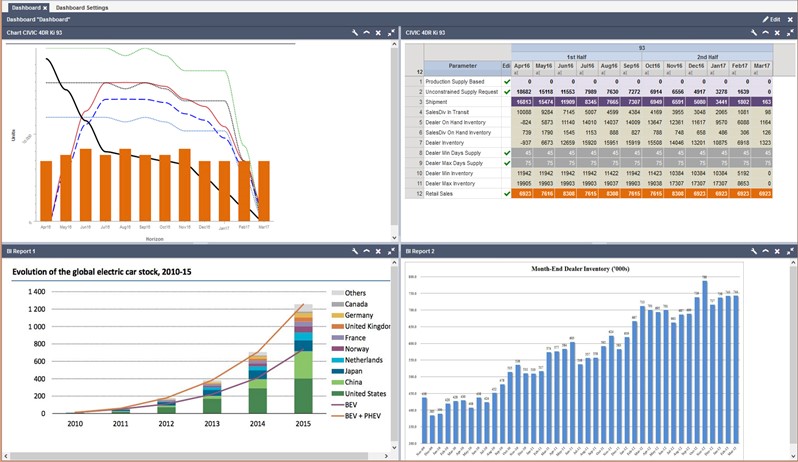Sales and operations planning (S&OP) is an essential tool for manufacturers, providing reliable short- to long-range forecasts of market needs.
It is an effective complement to enterprise resource planning (ERP) and manufacturing execution systems (MES) solutions during normal business cycles. It becomes a critical component when encountering unforeseen events such as the current COVID-19 pandemic.
It enables internal resources to be quickly allocated to meet changing production targets without incurring unnecessary costs.
Unanticipated disruption can derail the smooth operations of manufacturing in a global economy. In a sudden turn of events, manufacturers are challenged to find alternative sources for critical parts to prevent an interruption of production.
This is particularly true for the automotive industry, which is dependent on suppliers, manufacturers and customers in multiple countries.
The Unique Requirements of Forecasting for Automobile Manufacturers and Suppliers
Unlike for consumer goods and simpler products, it is not possible to apply statistical forecasting as a basis for sales planning in the automotive industry.
Trending, and other methods of statistical forecasting with extrapolation of references into future planning cycles, cannot forecast accurately and predict free-market demands. Historical sales figures often are driven by capacity restrictions, incentive initiatives and other factors influencing demand.
AI and analysis of social media are possible means of verifying capacity needs but cannot provide reliable results yet.
However, a viable alternative exists. By analyzing key performance indicators (KPIs) of sales data, along with information sources such as micro- and macro-economic predictions by analysts, the seasonal patterns of sales can be defined with greater certainty.
The Products Lifecycle
All of this information must be available to planners who then can make the best educated forecast of needed bandwidth and risk factor parameters. Intelligent S&OP not only means the ability to accurately forecast a demand and establish the referring capacity but also to forecast the bandwidth needed to provide flexibility.
In the automotive industry, planning occurs on different levels of the product hierarchy, never on fully specified product; there simply are too many variables.
Planning exists on higher levels, for example, on model selection or trim or option packages. An S&OP solution must provide this level of detail for planners to maintain consistent production.
Manufacturers rely on sophisticated ERP solutions for the efficient operations of the enterprise, but ERP solutions alone are not adequate to help companies quickly pivot to new strategies.
Sales & Operations Planning (S&OP) technology solutions complement the power of ERP platforms and provide manufacturers with the opportunity to plan for how to overcome potentially crippling crises.
Strategic and Tactical Planning Processes
An integrated and agile plan not only considers today’s market conditions, but also anticipates future conditions, including strategic and tactical planning processes.
With sales planning, manufacturers can quickly revise expectations for sales and corresponding production output. Short- and long-range forecasts are highly volatile and companies must respond quickly to changing market conditions which demand adjustments of production volumes and capacities.
Production and capacity planning anticipates required parts and capacities while taking into consideration working time models and line speeds, including losses through plant and equipment changes and other downtimes in the plants and lines. Balancing demand and capacity minimizes the risk of disruption in supply availability and allows the flexibility for late order changepoints.
Using inventory planning, companies can supply markets with the ideal product inventory. In the journey through the supply chain from raw materials to finished goods there can be many required adjustments.
Planning makes that possible by considering What-if? Scenarios. By using What-if exercises, manufacturers can respond to changing situations and determine the best solution after considering all options.
Good Data Drives Good Decision-Making
Business decisions concerning investments on the capacity and sales side are based on the S&OP process and its KPIs. Decision-making is supported by technology allowing end-to-end visibility and full transparency into the enterprise.
Graphical dashboards (above) display embedded analytics and enable decision-makers to turn immense amounts of data into actionable decisions. Individual panes can be combined based on the information needs of management, providing insight into the most relevant data points.
Planning Makes Perfect
No manufacturing enterprise can operate at optimum efficiency without a robust Sales and Operations Planning solution working with its ERP platform. This technology is even more crucial when market conditions require a quick pivot to maintain production continuity due to disruptive events.
No S&OP solution can predict when a game-changing event will strike, but it can provide the tools to consider alternative courses of action, identify the best options to meet the challenge and minimize damage.
A robust S&OP solution working with a comprehensive ERP platform gives manufacturers the tools to operate at maximum efficiency while retaining the flexibility to respond quickly when market conditions dictate.
Robin Hornung, managing director at flexis AG, is responsible for S&OP and demand capacity management.





